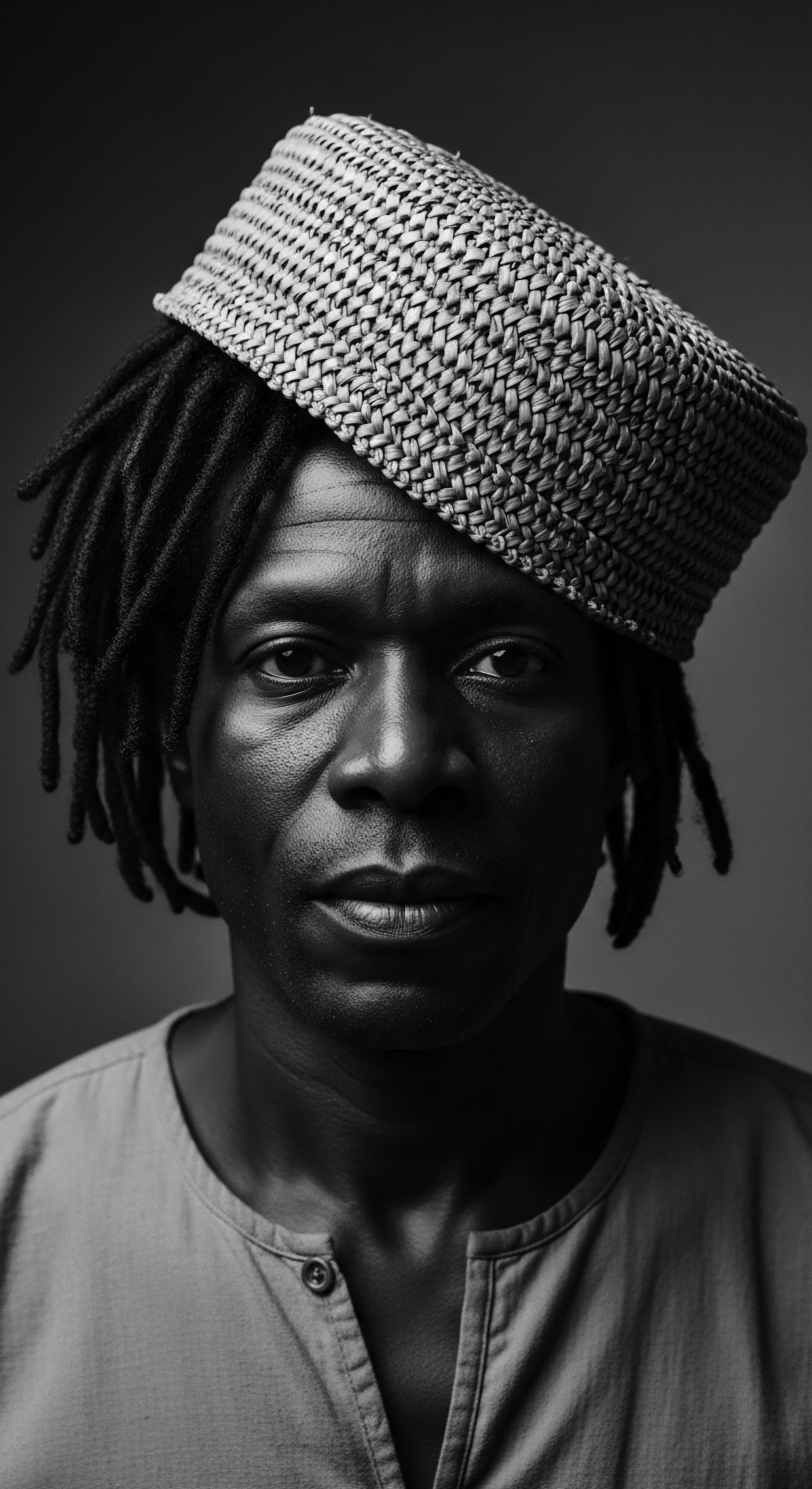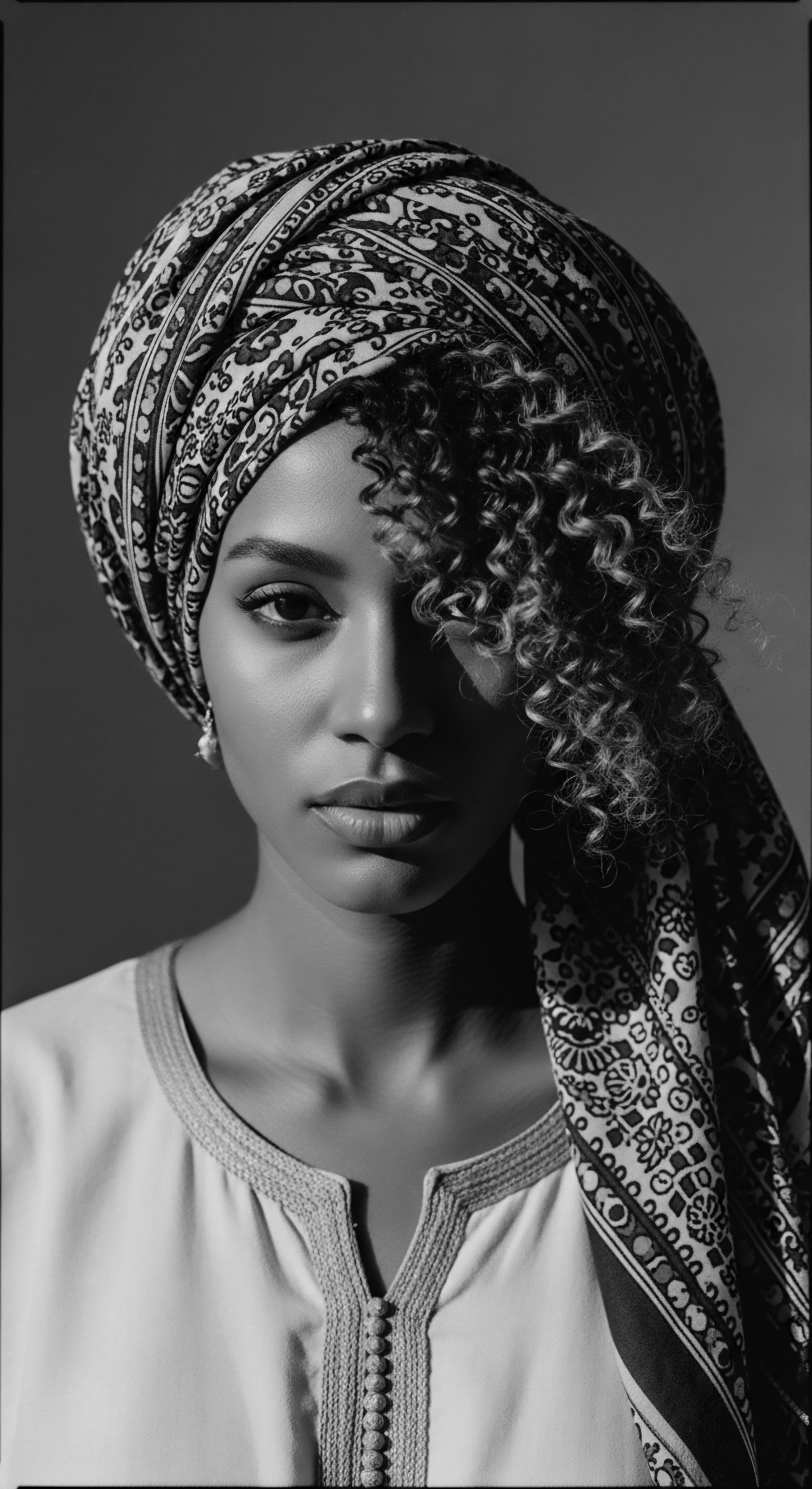
Fundamentals
The concept of Henna Practices, at its core, speaks to a venerable tradition, a living archive of wisdom passed through generations concerning the adornment and care of the human form, especially hair. This tradition centers around Henna, a natural dye derived from the leaves of the henna plant, Lawsonia inermis. When these leaves are dried, crushed into a fine powder, and then mixed with a liquid, they release a pigment called Lawsone. This crimson molecule possesses a remarkable affinity for the keratin found in hair, skin, and nails, creating a lasting stain.
For those encountering Henna Practices for the first time, its meaning extends far beyond mere cosmetic alteration. It represents an ancient dialogue between humanity and the earth, a recognition of natural elements as agents of beauty, protection, and spiritual connection. The application of this plant-based dye to hair is not a fleeting trend, but a ritual embedded in the cultural heritage of numerous communities worldwide. Its origins trace back thousands of years, with evidence of its use found in diverse ancient civilizations across North Africa, the Middle East, and South Asia.
Henna Practices are an enduring testament to ancient human ingenuity, transforming a simple plant into a profound cultural symbol of beauty and connection.
The application of henna to hair offers a spectrum of benefits that have long been valued in traditional care regimens. Beyond its obvious dyeing capabilities, it functions as a natural conditioner, adding remarkable sheen and strength to hair strands. It also provides a protective layer, helping to shield hair from environmental aggressors. For textured hair, this aspect is particularly noteworthy, as the unique structure of curls and coils often benefits from practices that enhance moisture retention and reinforce the cuticle.
The elemental interaction of lawsone with hair’s protein structure creates a gentle yet effective bonding, contributing to the hair’s overall resilience. This practice is not about covering or masking one’s natural hair, but about enhancing its innate qualities and honoring its heritage.
Understanding Henna Practices necessitates an appreciation for its simplicity and its profound impact. It is a process that begins with the earth, moves through careful preparation, and culminates in a personal or communal act of embellishment and care. The hues achieved range from auburn to deep reddish-brown, depending on the individual’s natural hair color and the blend of the henna paste. The experience itself is often tactile and sensory, engaging touch and sight, linking the individual to a legacy of beauty practices that predate modern formulations.

Intermediate
Moving beyond the elemental comprehension, the intermediate understanding of Henna Practices delves into its deeper connotations, particularly within the vast and varied landscapes of textured hair heritage. This traditional practice is not merely a coloring agent; it serves as a tender thread woven through the fabric of ancestral knowledge, embodying rituals of self-care, community bonding, and the assertion of identity. For Black and mixed-race hair experiences, this connection is particularly resonant, as historical narratives reveal how hair has always been a powerful medium for cultural expression and resistance against homogenizing beauty standards.
The Meaning of Henna Practices expands when viewed through the lens of holistic wellness, a concept deeply ingrained in many ancestral care systems. The application of henna is often accompanied by other natural ingredients like herbs and oils, creating a synergistic effect that benefits the scalp and hair fiber. Traditional practitioners understood that healthy hair originated from a nourished scalp, a wisdom that modern trichology increasingly affirms. Henna’s mild astringent properties contribute to a balanced scalp environment, which is paramount for the healthy growth of textured hair, often prone to dryness or product build-up.
Henna Practices represent a legacy of holistic hair wellness, where the natural world offers sustenance and strength to textured strands.
The practice transcends the individual, often becoming a communal ceremony. In many African, Middle Eastern, and South Asian traditions, the application of henna for hair is a shared experience, particularly among women. These moments foster connection, intergenerational learning, and the transmission of intangible cultural heritage.
Elders share their wisdom with younger generations, demonstrating precise mixing techniques, discussing the spiritual significance of the designs, and imparting knowledge about hair health that has been refined over centuries. This collective approach to beauty rituals stands in contrast to often isolated modern practices, highlighting the community-building aspect inherent in Henna Practices.
Consider the intricate relationship between hair and identity, especially within diasporic communities. Hair has long been a canvas for storytelling, a marker of status, spiritual belief, and defiance. Henna, with its rich, earthy hues, offers a way to adorn and define one’s crown while honoring ancestral ways.
Its natural composition provides an alternative to harsh chemical dyes, which can be damaging to the delicate protein structure of textured hair, causing breakage and dryness. The choice to utilize henna can be a conscious act of returning to traditional methods, a reclamation of cultural practices, and an assertion of self-love for one’s inherent hair type.
The Delineation of Henna Practices also acknowledges the subtle variations across different cultural contexts. While the plant remains the same, the specific preparations, additives, and ritualistic timings can differ significantly.
- North African Henna Applications ❉ Often incorporate black tea or coffee for deeper shades, and sometimes protective oils, with uses extending to ceremonial pre-wedding rituals or daily hair fortification.
- West African Hair Traditions ❉ While less dominant than in North Africa, certain groups have historically used henna alongside other natural dyes like kola nut for reddish tints, especially for protective styles or ritualistic hair painting.
- South Asian Hair Rituals ❉ Frequently involve complex herbal blends with henna, such as amla and shikakai, tailored for promoting hair growth, conditioning, and vibrant color, deeply integrated into beauty and healing systems.
Understanding these regional distinctions deepens one’s appreciation for the practice’s adaptability and its deep resonance with diverse expressions of heritage. Henna, therefore, is not a monolithic practice, but a dynamic, culturally responsive tradition.

Academic
The academic Definition of Henna Practices transcends a mere description of its botanical origins or cosmetic application, presenting instead a complex socio-cultural phenomenon deeply interwoven with historical anthropology, ethnobotany, and the psychology of identity, particularly as it pertains to textured hair. At this sophisticated stratum of comprehension, Henna Practices signify a profound, enduring human engagement with natural pigments, an engagement that has shaped communal aesthetics, ritualistic expressions, and personal adornment across vast geographical and temporal expanses, with notable significance for the hair traditions within Black and mixed-race diasporas. It is an intricate dialogue between the human desire for self-expression and the earth’s yielding bounties, articulated through centuries of inherited wisdom.
From an ethnobotanical perspective, Lawsonia inermis, the henna plant, offers more than just a dye. Its leaves contain lawsone (2-hydroxy-1,4-naphthoquinone), a chemical compound that covalently bonds with the keratin protein of hair, skin, and nails, resulting in a semi-permanent stain. This interaction, though understood chemically only in recent centuries, was implicitly comprehended and harnessed by ancestral cultures through empirical observation and meticulous practice.
The traditional knowledge systems that perfected henna preparation—from sun-drying and grinding to the optimal pH for dye release through acidic additives like lemon juice or tea—demonstrate a sophisticated, albeit non-codified, understanding of phytochemistry and material science. The consistent application of these practices across millennia speaks to their efficacy and the deep, iterative learning cycles within these communities.
The enduring practice of henna application showcases an ancestral phytochemistry, where generations intuitively grasped the intricate bond between plant compounds and human keratin.
The significance of Henna Practices within textured hair heritage, particularly across African and African-diasporic contexts, offers a compelling area of inquiry. Historically, hair has served as a powerful signifier of lineage, status, age, spiritual connection, and collective identity in numerous African societies. The manipulation and adornment of hair were not superficial acts but integral components of social structure and personal narrative.
While Western beauty standards have often stigmatized textured hair, ancestral traditions celebrated its diversity, resilience, and unique aesthetic possibilities. Henna, alongside other natural dyes and emollients, became a tool in this expansive repertoire of hair care.
Consider the compelling historical evidence of henna’s strategic use in the Western Sahel, specifically among various groups with deep historical connections to indigenous African hair traditions. While often associated primarily with North Africa and the Middle East, its journey across the Sahara and integration into specific Sub-Saharan practices presents a profound insight. For instance, among some communities in what is modern-day Niger and Mali, particularly those with nomadic or semi-nomadic L’Tuareg heritage, henna has been incorporated into hair and body adornment for ceremonial occasions, signifying rites of passage, spiritual protection, and aesthetic elevation. This practice underscores a deep cultural cross-pollination.
Nancy Tolford’s (1985) Seminal Work, “The Art of Black Africa,” while broadly surveying African art, provides indirect but powerful context for understanding how natural substances, including plant-based dyes like henna, were meticulously employed in rituals that affirmed identity and celebrated indigenous beauty standards. Although Tolford’s text primarily focuses on sculptural and mask traditions, its exploration of body adornment and its integral role in signifying social standing and spiritual belief systems in West African societies allows for a broader interpretation of how natural pigments, like henna, became interwoven with personal and communal identity, including hair. This context suggests a heritage of intentionality and deep meaning behind cosmetic choices.
The purposeful application of henna to textured hair, often braided or intricately styled, served multiple functions:
- Protective and Strengthening Agent ❉ Henna’s ability to bind to the keratin cuticle provided a natural shield against environmental elements (sun, dust) and reduced moisture loss, crucial for maintaining the integrity of coiled and kinky hair types in arid climates.
- Symbolic Adornment ❉ Beyond color, the reddish tint conferred by henna carried spiritual or social significance, often associated with vitality, good fortune, or protection from malevolent forces. The color itself became a visual language.
- Cultural Continuity ❉ In the face of external influences, the continued use of traditional practices like henna became an act of cultural maintenance, a quiet assertion of heritage and identity in a world often seeking to erase it.
The integration of henna into these practices was not a superficial borrowing, but a nuanced adaptation that aligned with pre-existing ancestral philosophies of hair as a living, sacred entity. This challenges a simplistic view of cultural exchange, revealing instead a selective incorporation that served to bolster and redefine existing self-expressions.
The Meaning of Henna Practices in the context of globalized beauty standards and the natural hair movement requires further academic scrutiny. The resurgence of interest in henna among contemporary Black and mixed-race individuals often represents a conscious deviation from chemically harsh alternatives that historically compromised hair health and reinforced Eurocentric beauty ideals. This return to ancestral remedies is a form of embodied resistance, a reclamation of self-definition rooted in cultural heritage rather than imposed norms. It is a psychological act of empowerment, choosing agency in how one’s hair is adorned and cared for, thereby affirming a connection to a long lineage of resilience and self-determination.
The pedagogical value of understanding Henna Practices, particularly for individuals with textured hair, lies in its capacity to connect present-day care routines with deep historical currents. It allows for a critical examination of product ingredients, promoting an informed choice towards natural alternatives. The interdisciplinary nature of Henna Practices, bridging botany, chemistry, anthropology, and sociology, positions it as an exceptional case study for examining the complex relationship between nature, culture, and identity. Its continued relevance highlights the enduring wisdom of ancestral care and its profound implications for holistic wellbeing in contemporary life.
This conceptual richness underscores the importance of a detailed, nuanced understanding of Henna Practices.
| Aspect of Hair Color/Care Pigment Source |
| Ancestral Insight (Pre-Scientific Understanding) Identified specific plants (e.g. henna, indigo) through trial and error, observing their staining properties on hair and skin. |
| Modern Scientific Elucidation (Post-19th Century) Chemical analysis isolated specific molecules (e.g. lawsone from henna, indigotin from indigo) responsible for color, detailing their molecular structure and bonding mechanisms. |
| Aspect of Hair Color/Care Color Longevity & Hair Binding |
| Ancestral Insight (Pre-Scientific Understanding) Noticed colors lasted longer and bonded better with certain preparations; attributed this to plant 'spirit' or innate properties. |
| Modern Scientific Elucidation (Post-19th Century) Understood the covalent bond formation between lawsone and keratin, explaining its semi-permanent nature and resistance to washing, contrasting with temporary dyes. |
| Aspect of Hair Color/Care Hair Strengthening & Conditioning |
| Ancestral Insight (Pre-Scientific Understanding) Observed increased shine, thickness, and reduced breakage in hair treated with henna; believed it 'sealed' or 'protected' the hair. |
| Modern Scientific Elucidation (Post-19th Century) Explained how lawsone molecules deposit on the hair's cuticle, adding a protective layer, potentially increasing shaft diameter and strengthening the hair by filling in microscopic gaps. |
| Aspect of Hair Color/Care Scalp Health & Cleansing |
| Ancestral Insight (Pre-Scientific Understanding) Recognized certain plant preparations (e.g. henna, soap nuts) contributed to a cleaner, healthier scalp; used for both cleansing and medicinal purposes. |
| Modern Scientific Elucidation (Post-19th Century) Identified antimicrobial, antifungal, and astringent properties of plant compounds that regulate sebum production and combat scalp issues, leading to healthier follicular environments. |
| Aspect of Hair Color/Care Ritualistic Application |
| Ancestral Insight (Pre-Scientific Understanding) Hair adornment deeply integrated into rites of passage, spiritual ceremonies, and social identity; the act of application was communal and significant. |
| Modern Scientific Elucidation (Post-19th Century) Anthropological and sociological studies describe the role of hair in cultural identity and the psychology of ritual, validating the non-cosmetic significance of traditional hair practices in community cohesion and personal expression. |
| Aspect of Hair Color/Care This table illuminates how much of ancestral wisdom regarding natural hair care, exemplified by Henna Practices, finds contemporary validation through scientific lenses, affirming a profound heritage of empirical knowledge. |
This rigorous understanding reveals Henna Practices not as a quaint historical footnote, but as a living system of knowledge that continues to offer vital insights into sustainable beauty, cultural preservation, and the enduring power of natural substances.

Reflection on the Heritage of Henna Practices
The enduring vitality of Henna Practices invites a profound reflection on the soul of a strand—how each curl, coil, and wave carries not only genetic code but also the echoes of generations. This ancient art, so deeply intertwined with the earth’s rhythm and human expression, continues to offer a rich narrative for textured hair. Its journey from elemental biology to a beacon of identity speaks to a resilience that mirrors the very hair it graces. The careful preparation of henna, the meditative application, and the vibrant hues that blossom upon the hair are more than aesthetic choices; they are acts of remembrance, connecting us to ancestral hands that performed similar rites under different skies.
For those with Black and mixed-race hair, the heritage of Henna Practices represents a gentle reclaiming of beauty standards, a quiet revolution against narratives that once sought to diminish our innate hair textures. It is a testament to the ingenuity of our forebearers, who looked to the natural world for sustenance and adornment, long before laboratories synthesized artificial alternatives. This practice offers a path to holistic well-being, acknowledging hair as an integral part of the self, deserving of reverence and thoughtful care. It reminds us that true beauty flows from a deep connection to our origins, a celebration of what has been passed down through time, and a conscious choice to honor it in our present.
The legacy of Henna Practices reminds us that true hair care flows from a reverence for heritage, connecting past wisdom to future beauty.
The story of henna, painted onto each strand, is a testament to the enduring power of cultural continuity. It whispers of community gatherings, of shared laughter and wisdom exchanged across thresholds of age. It signifies a future where hair care is not merely a routine but a sacred dialogue with one’s ancestral lineage, a vibrant demonstration of self-love and cultural pride.
As we continue to rediscover and reinterpret these practices, we contribute to a living archive, ensuring that the ancient wisdom of the henna plant continues to nourish not just our hair, but our very spirit, for generations yet to come. It is a profound, beautiful conversation, spanning centuries and continents, forever linking the earth, our hair, and our heritage.

References
- Tolford, Nancy. (1985). The Art of Black Africa.
- Al-Rubaya, A. (2014). Henna ❉ A Natural Cosmetic with Potential Therapeutic Applications. Journal of Dermatology & Dermatologic Surgery, 18(1), 11-18.
- Choudhary, M. I. et al. (2007). Phytochemical and Pharmacological Studies on Lawsonia inermis. Pure and Applied Chemistry, 79(12), 2217-2224.
- Ghasemi, M. & Kianmehr, M. (2018). History and Health Benefits of Henna. Journal of Medicinal Plants Research, 12(28), 452-458.
- Puranik, S. & Kumari, N. (2020). Hair Dyeing with Herbal Formulations ❉ A Review. International Journal of Applied Research, 6(11), 32-35.
- Picton, J. & Mack, J. (1989). African Textiles ❉ Looms, Weaving and Design.
- Kassas, M. (2002). Indigenous Knowledge and Environment. Environmental Conservation, 29(4), 421-424.
- Oyelade, O. J. (2019). The Cultural and Traditional Significance of Hair Braiding in African Societies. Journal of Black Studies, 50(2), 173-190.
- El-Kamali, H. H. (2009). The Traditional Medicinal Uses of Lawsonia inermis Linn. (Henna) in Sudan. Journal of Ethnopharmacology, 122(2), 209-219.
